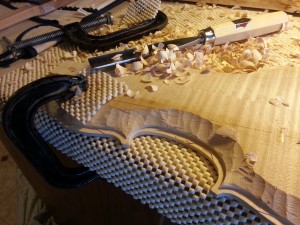And now I carve. I am settled in to the routine and it hits me, truly, that this is not an overnight task. I mean, I knew it would take time, of course I knew it. Brian said he calculated that it takes a student around 300 hours to complete an instrument. That’s a lot of hours. And much of the time is spent in the detailed work. The carving and measuring, the ceaseless carving and measuring. I have finished my rough arching, which gets the wood to the basic shape and now I have to work the platform. I am nervous about the platform. Carving things flat is difficult. I seem to list to one side or the other. And while I worry about the measurements and destroying the wood, I find myself thinking about the long tradition whose coattails I am grabbing onto.
I listened to a Radio Lab podcast the other day and the theme was Things. http://www.radiolab.org/story/things/ (If you’ve never listened to Radio Lab, you must, it’s not an option, go, listen…..) In the opening sequence Robert Krulwich discusses the difference between how he and his wife relate to things, specifically things from the past. Things that have cultural, emotional, scientific significance. And it got me thinking about my relationship to things and how they spur the imagination. My husband and I were on a trip to England and we had just visited the Daphne de Maurier museum on Bodmin Moor. We meandered around the moor on our way to find a place to spend the night and on the way one of the maps said we were near an historical ruin. We found the spot to park our car but there was no real clear signpost as to where we were supposed to go. We were racing the daylight but I really wanted to see the ruin and didn’t want to give up. We finally found it. I don’t know exactly what I’d expected but it turned out that the ruin was nothing more than the rock footprint of a town or village. It was clear that the rocks were not random. I could imagine the walls that had arisen from the rocks. It was a medieval ghost town. There weren’t even things at that spot just stones laid out but I imagined the people walking and sitting and knitting and cooking and arguing and crying.
And what does all this have to do with me making a violin? As I scrape away my millimeters of wood I find myself connected in a very tactile way to the past. It is as if I touch the past as if I carve away more than wood. I carve away years, I carve away time. I time travel. This violin I am making, the violin I now play, the violin that is played in the concert hall, the violin that is played in the mountains of West Virginia, the violin that is played in the Mariachi band, the violin that is played in Scotland, Ireland, Rumania, the violin that is played in rock band, all of them every last one are born of the same beginnings. They all trace their source back to the workshops of 15th century Italy. And I carve the way they carved. I scrape and file and measure with almost exactly the same tools. The music played may be different, the music arises from the individual cultures, but the instrument spans them all. The instrument binds us.


Marcy, I love the time travel theme in this one and the connections you sense and the bind you feel.